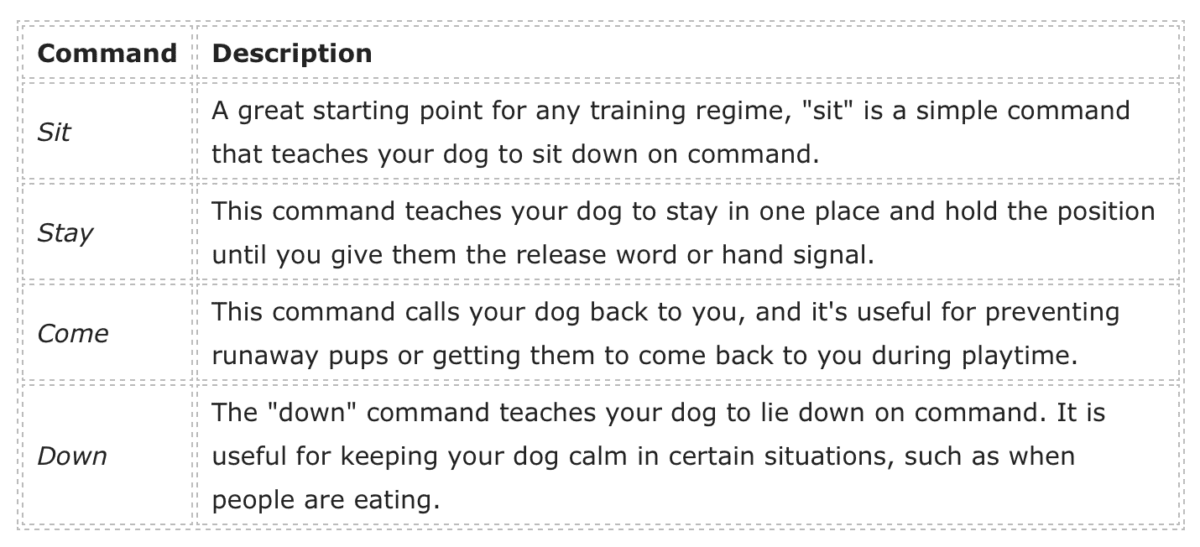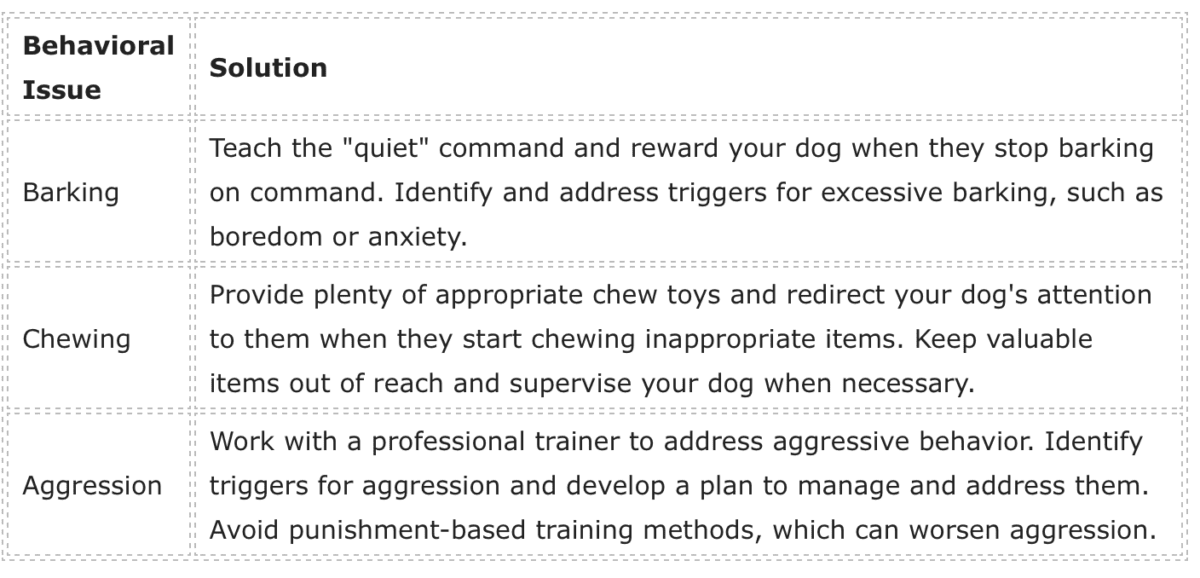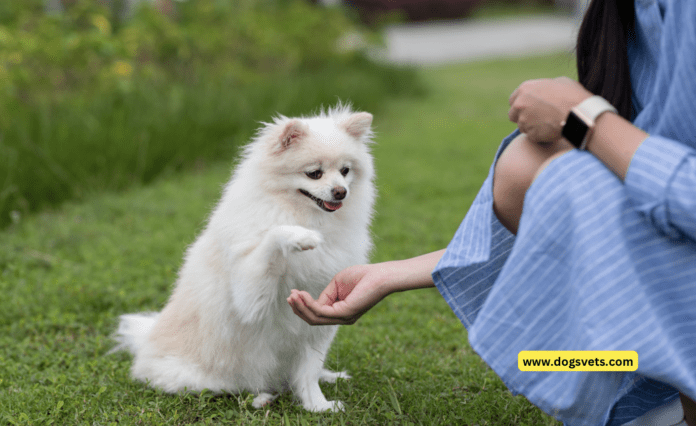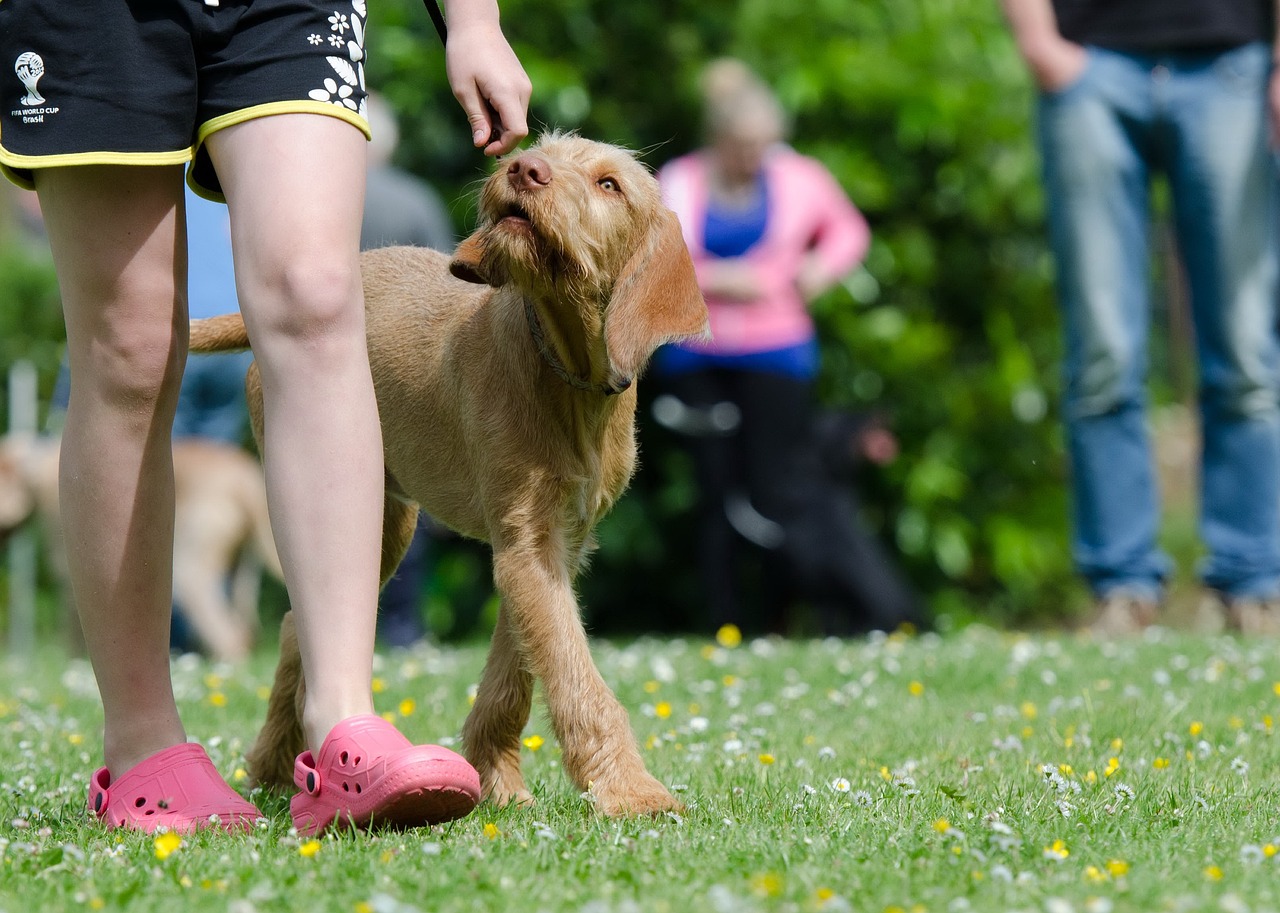Last Updated on September 1, 2023 by Dogs Vets
What is Dog Training and How it Strengthens Your Bond with Your Pet
Welcome to our comprehensive guide on dog training, including insights into the benefits of the best online dog training courses. As a pet parent, you want your furry companion to be well-behaved and disciplined.
Dog training is the process of teaching your dog certain behaviors and commands, which can help strengthen your bond with your pet and make your life easier.
Through effective training, you can build a stronger connection with your furry friend, improve their obedience, and reduce behavioral issues.
In this section, we will introduce you to the concept of dog training and how it can strengthen the bond between you and your pet.
Key Takeaways
- Dog training is the process of teaching your furry friend certain behaviors and commands.
- Effective training can improve obedience, reduce behavioral issues, and strengthen your bond with your pet.
The Benefits of Dog Training
Dog training is an essential part of pet ownership that offers numerous benefits for both you and your furry friend.
Not only can it improve your communication and understanding of your pet’s behavior, but it can also strengthen your bond and make your life together more enjoyable. Below are some of the key benefits of dog training:

Overall, dog training is an incredibly rewarding experience that can provide numerous benefits for both you and your furry friend.
Whether you’re looking to improve your communication, correct unwanted behaviors, or just have fun together, there’s no better time to start training your dog than now!
Understanding Dog Behavior
Understanding dog behavior is a crucial aspect of effective training. Just like humans, dogs have their own unique personalities, tendencies, and ways of communicating.
By understanding their body language and behavior, you can better communicate with your furry friend and give them the guidance they need to succeed.
One of the first things to consider when training your dog is their breed. Different breeds have different temperaments and traits, which can affect their behavior and learning style.
For example, a high-energy breed like a Border Collie may require more physical stimulation and mental challenges than a laid-back breed like a Basset Hound.
It’s also important to recognize how your dog communicates with you and other animals. This could include things like tail wagging, barking, growling, and body posture.
By observing your dog’s behavior in different situations, you can identify potential triggers for negative behaviors and work to redirect them in a positive way.
Understanding Positive Reinforcement Training
Positive reinforcement training is a popular approach to dog training that focuses on rewarding desired behaviors rather than punishing unwanted ones.
This method involves using treats, toys, and other rewards to incentivize your dog and encourage good behavior. By reinforcing positive behavior, you can help your dog develop a stronger bond with you and feel more confident in their abilities.
When using positive reinforcement, it’s important to be consistent and clear with your commands.
Use simple and direct language to communicate what you want your dog to do, and always reward them immediately after they perform the desired behavior. With enough practice and consistency, positive reinforcement can be an effective way to teach your dog new tricks and behaviors.
Basic Dog Training Commands
Training your dog with basic commands is essential for building a strong foundation in communication and obedience. These commands will help your dog understand what is expected of them and respond accordingly.

It’s important to teach each command using positive reinforcement.
Praise and treats can be used to reward good behavior, and repetition is key to making sure the commands stick. Start with short sessions, and gradually increase the duration and level of difficulty as your dog becomes more comfortable.
Positive Reinforcement Training
Positive reinforcement training is a popular method of dog training that relies on rewarding desired behavior to encourage its repetition. This form of training is based on the idea that dogs will repeat behaviors that are rewarded, while behaviors that are not rewarded will eventually decrease.
The primary goal of positive reinforcement training is to create a strong bond between you and your dog based on trust, respect, and cooperation.
It avoids the use of punishment or negative reinforcement, as these can damage the bond and lead to unwanted behaviors.
Examples of positive reinforcement include giving your dog treats, praise, and attention when they exhibit desired behavior. This can encourage your dog to repeat the behavior in the future, creating a positive and rewarding training experience for both you and your pet.
Clicker Training for Dogs
Clicker training is a positive reinforcement technique that uses a sound, typically a click, to communicate with your dog.
It marks the exact moment your dog performs the desired behavior and is followed by a reward, usually a treat or praise. Here are some of the benefits of clicker training:
- Clear communication: The clicker provides a clear and consistent sound that your dog can associate with a reward. This makes it easier to communicate what you want your dog to do.
- Faster learning: Clicker training can help your dog learn faster and retain the behavior better than traditional training methods.
- Positive experience: Clicker training is a positive experience for your dog, as it focuses on rewarding good behavior rather than punishing bad behavior.
To get started with clicker training, you’ll need a clicker and some treats. Here’s how to train your dog using a clicker:
- Charge the clicker: Before you can use the clicker to communicate with your dog, you need to charge it. To do this, simply click the clicker and immediately give your dog a treat. Do this several times so your dog associates the sound of the click with the reward.
- Start training: Once your dog understands that the clicker means a reward is coming, you can start training. Click the clicker when your dog performs the desired behavior and immediately give them a treat. Repeat this several times until your dog understands what you want them to do.
- Add a cue: Once your dog understands the behavior you want them to perform, you can add a cue, such as a verbal command or a hand signal. Click the clicker when your dog performs the behavior in response to the cue and reward them with a treat.
- Generalize the behavior: Once your dog has learned the behavior, you need to generalize it to different environments and situations. Practice the behavior in different locations and add distractions gradually.
Clicker training can be used to teach your dog a variety of behaviors, from basic obedience commands to more complex tricks and agility maneuvers. It’s a fun and effective way to train your dog and strengthen your bond.
Crate Training Your Dog
Crate training is a popular method of house-training dogs, as it offers a comfortable and safe space for your furry friend, while also helping to prevent destructive behavior.
To start crate training, begin by introducing your dog to the crate slowly, allowing them to explore it at their own pace. You can make the crate more appealing by adding comfortable bedding and toys.
Once your dog is comfortable inside the crate, begin to close the door for short periods of time while you are home. Gradually increase the length of time the door is closed, while ensuring your dog has access to water and toys.
It’s important to use positive reinforcement when crate training, praising your dog when they enter the crate and offering treats. Never use the crate as a punishment, as this can lead to negative associations.

By following these steps and being patient with your dog, you can successfully crate train them and provide them with a safe and comfortable space of their own.
Leash Training and Walking Etiquette
Leash walking is an essential skill for every dog owner to teach their pet. Not only does it keep your dog safe during walks, but it also ensures they are well-behaved in public spaces. Here are some tips for leash training and teaching your dog proper walking etiquette:
- Start early: Puppies should start learning leash walking from a young age. Introduce them to the leash gradually, allowing them to sniff and explore it before attaching it to their collar. Make sure the leash is the right length for your dog’s size.
- Be consistent: Use the same commands every time you walk your dog, such as ‘heel’, ‘let’s go’, or ‘stop’. Consistency will help reinforce good behavior.
- Use positive reinforcement: Reward your dog with treats, praise, and playtime when they walk calmly beside you. This reinforces the behavior you want to see.
- Keep walks short: Especially when starting out, keep walks short and manageable. This will help your dog focus and stay engaged.
Walking etiquette is also important when out in public spaces. Here are some basic rules to follow:
- Always pick up after your dog: Bring a bag with you and pick up any poop your dog leaves behind. This helps keep public spaces clean and prevents the spread of disease.
- Keep your dog on a leash: Even if your dog is well-trained, it’s important to keep them on a leash in public spaces. This prevents them from running off or getting into fights with other animals.
- Be aware of your surroundings: Pay attention to other people and dogs in the area. If your dog is reactive or anxious around other dogs, give them plenty of space and avoid crowded areas.
- Don’t let your dog jump on people: Some people may not appreciate a friendly dog jumping up on them. Teach your dog to greet people calmly and politely.
With patience, consistency, and positive reinforcement, leash training and walking etiquette can become second nature for both you and your furry companion.
Socializing Your Dog
Socializing your dog is crucial for their overall well-being and development. By introducing your dog to new people, animals, and environments, you can help them become more confident and well-adjusted.
One important aspect of socializing your dog is to expose them to different types of people. This can include people of different ages, races, genders, and physical abilities. It’s essential to ensure these interactions are positive and that your dog feels comfortable and safe.
Another important aspect of socializing your dog is to introduce them to other animals. This can include other dogs, cats, and even smaller animals like rabbits and guinea pigs. It’s important to supervise these interactions and ensure they are safe for all animals involved.
It’s also important to introduce your dog to different environments. This can include parks, beaches, and even busy city streets. By exposing your dog to new environments, you can help them become more adaptable and less anxious in unfamiliar situations.
Keep in mind that socializing your dog is an ongoing process. It’s important to continue introducing them to new experiences throughout their life to ensure they remain well-adjusted and confident.
Advanced Training Techniques
Once your dog has mastered the basic commands, you may want to challenge their abilities with more advanced training techniques. These exercises can be used to strengthen your bond and provide mental and physical stimulation for your pet.
Agility Training
Agility training involves teaching your dog to navigate obstacles such as jumps, tunnels, and weave poles in a timed setting. This sport is not only fun for dogs, but also provides excellent exercise and mental stimulation.
When starting agility training, it’s important to introduce each obstacle one at a time and provide plenty of positive reinforcement. Gradually increase the difficulty level as your dog becomes more comfortable with the course.
Scent Detection
Scent detection training involves teaching your dog to identify and locate specific scents, such as drugs or explosives. This type of training is often used by law enforcement or search and rescue teams, but can also be a fun activity for dogs and their owners.
To begin scent detection training, start with a strong-smelling treat or toy and encourage your dog to find it. Gradually increase the difficulty level by hiding the item in more challenging locations or introducing new scents.
With consistent training, your dog can become proficient in scent detection and may even be able to pass a certification test.
Addressing Behavioral Issues
Dogs can exhibit a range of behavioral issues, and it’s important to address them promptly. Ignoring these issues can lead to more serious problems down the line, so it’s best to address them early on. Here are some common behavioral issues and how to address them:

It’s important to remember that every dog is different, and some may require more specialized training for their specific behavioral issues. Consult with a professional trainer or behaviorist for personalized guidance.
Training for Specific Dog Breeds
Training your dog is not a one-size-fits-all approach. Different breeds have different temperaments and behavioral tendencies that need to be taken into consideration during training. Here are some breed-specific training tips to keep in mind:

Remember that each dog is an individual and may not fit perfectly into breed stereotypes. It’s important to observe your dog’s behavior and tailor training methods to their specific needs and abilities.
Training Your Dog for Special Situations
Training your dog for special situations is an important part of their overall training. It can help ensure that your dog is well-behaved and safe in a variety of circumstances. Here are some tips for training your dog for specific situations:
Off-Leash Activities
Before allowing your dog to roam off-leash, it’s important to make sure they have a strong recall. Practice recall training in a safe, enclosed area before trying it in an open space. Start with short distances and gradually increase the distance as your dog becomes more reliable. It’s also important to teach your dog to stay close to you and to be aware of your surroundings.
Traveling
Traveling with your dog can be stressful for both you and your pet. To help your dog feel more comfortable, start by getting them used to the car. Take short trips to fun destinations, and provide a comfortable crate or bed for them to relax in.
It’s also important to make sure your dog is properly restrained while in the car to prevent injury in case of an accident. Finally, make sure your dog is up to date on all necessary vaccinations and has identification tags with your contact information.
Visits to the Vet
Many dogs dislike going to the vet, but with proper training, you can help your dog feel more comfortable during visits. Start by getting your dog used to being handled by touching their paws, ears, and other sensitive areas.
Practice walking your dog on a leash and getting them used to the car. Finally, consider using positive reinforcement techniques during vet visits, such as giving treats or playing with a favorite toy.
The Role of Online Dog Training Courses
Online dog training courses have become increasingly popular in recent years, offering a convenient and accessible way for pet owners to train their dogs from the comfort of their own homes.
These courses are designed to provide step-by-step guidance and instruction on various training techniques, making it easier for pet owners to understand and implement them with their dogs.
One of the main benefits of online dog training courses is the flexibility they offer.
Whether you have a busy schedule or live in a remote location, online courses allow you to work at your own pace and on your own schedule. This means you can fit training sessions into your day whenever is most convenient for you, without having to worry about traveling to a physical training location.
Online dog training courses also provide a cost-effective alternative to traditional training methods. While hiring a professional dog trainer can be expensive, online courses typically provide access to a wealth of instructional materials and resources at a fraction of the cost.
This makes it easier for pet owners to access quality training materials without breaking the bank.
In addition to these benefits, online dog training courses also allow for personalized instruction and feedback.
Many courses offer the option to submit videos of your training sessions for review by a professional dog trainer, who can then provide personalized feedback and guidance on how to improve your training techniques.
This level of individualized attention can be especially helpful for pet owners who may be struggling with a particular training issue or want to ensure they are effectively communicating with their dog.
Recommended Online Dog Training Courses
While there are many online dog training courses available, here are a few recommended options to consider:

No matter which online dog training course you choose, be sure to do your research and read reviews from other pet owners before making a decision.
With the right course and dedication to training, you can strengthen your bond with your dog and help them become a well-behaved and happy member of your family.
Conclusion
Training your dog is a crucial aspect of pet ownership that strengthens the bond between you and your furry friend. By understanding their behavior and using positive reinforcement techniques, you can improve communication, increase obedience, and prevent common behavioral issues.
From basic commands to advanced techniques and breed-specific training, there is a wide range of resources available to help you train your dog effectively. Whether you access online training courses or work with a professional trainer, the key is to start early and be consistent in your approach.
Remember that training is not just about obedience; it is also about having fun and building a deeper connection with your pet. With patience, persistence, and a lot of love, you can enjoy a lifetime of happy and fulfilling moments with your furry companion.
FAQ
Q: What is dog training and how does it strengthen the bond with your pet?
A: Dog training is the process of teaching your dog various commands and behaviors to ensure good behavior and obedience. Through training, you establish clear communication and boundaries with your pet, which strengthens the bond between you. It also helps your dog understand what is expected of them and builds trust and mutual understanding.
Q: What are the benefits of dog training?
A: Dog training has numerous benefits, including improved communication between you and your pet, increased obedience, and better behavior. It also provides mental stimulation for your dog, helps prevent behavioral issues, and enhances the overall quality of your relationship.
Q: Why is understanding dog behavior important for effective training?
A: Understanding dog behavior is essential for effective training because it allows you to address the underlying causes of certain behaviors and tailor your training methods accordingly. By understanding how dogs think and learn, you can effectively communicate with your pet and modify their behavior in a positive and rewarding way.
Q: What are some basic dog training commands?
A: Some basic dog training commands include sit, stay, come, down, and heel. These commands provide a foundation for good behavior and are essential for maintaining control and ensuring the safety of your dog.
Q: What is positive reinforcement training and how does it work?
A: Positive reinforcement training is a method of training that involves rewarding your dog for desired behaviors. This can be done through treats, praise, or play. By reinforcing positive behaviors, you motivate your dog to repeat them, making the training process more enjoyable and effective.
Q: What is clicker training and how can it be used?
A: Clicker training is a form of positive reinforcement training that uses a clicker, a small device that makes a distinct sound, to mark desired behaviors. The clicker serves as a signal to your dog that they have done something right, and they are then rewarded. Clicker training can be used to shape desired behaviors and teach your dog new tricks or commands.
Q: What is crate training and why is it useful?
A: Crate training involves teaching your dog to view their crate as a safe and comfortable space. It can be useful for various reasons, such as providing a secure environment for your dog when you are away, aiding in house training, and facilitating travel with your pet.
Q: How can I leash train my dog and teach proper walking etiquette?
A: Leash training your dog involves teaching them to walk calmly on a leash without pulling or dragging you. It is important to use positive reinforcement and reward your dog for walking politely by your side. Teaching proper walking etiquette includes training your dog to walk on a loose leash, to stay focused on you, and to respond to commands such as “heel” or “leave it.”
Q: Why is socializing my dog important and how can I do it?
A: Socializing your dog is crucial for their overall well-being and behavior. It exposes them to different people, animals, and environments, helping them become comfortable and confident in various situations. To socialize your dog, introduce them gradually to new experiences, seek positive interactions, and provide them with positive reinforcement for good behavior during socialization.
Q: What are some advanced training techniques for dogs?
A: Advanced training techniques for dogs include agility training, which involves navigating through an obstacle course, and scent detection training, where dogs learn to identify specific scents. These techniques challenge your dog’s abilities and provide mental and physical stimulation.
Q: How can I address common behavioral issues in dogs?
A: To address common behavioral issues in dogs, such as barking, chewing, or aggression, it is important to understand the root causes behind these behaviors. Seek professional guidance, implement positive reinforcement techniques, and be consistent in your training approach. Addressing behavioral issues early on can prevent them from becoming more problematic in the future.
Q: Why is breed-specific training important?
A: Breed-specific training recognizes that different dog breeds have unique characteristics, temperaments, and needs. Tailoring your training approach to suit your dog’s breed can ensure effective communication and address any specific challenges or behaviors associated with that breed.
Q: How can I train my dog for special situations?
A: Training your dog for special situations, such as off-leash activities, traveling, or visits to the vet, involves specific training techniques and preparation. Gradual exposure, positive reinforcement, and consistency are key elements in training your dog to behave appropriately in these situations.
Q: What role do online dog training courses play?
A: Online dog training courses offer convenience and flexibility, allowing you to learn and train your dog at your own pace and from the comfort of your own home. They provide valuable resources, expert guidance, and step-by-step instructions for effective training.
Fact Check
We strive to provide the latest valuable information for pet lovers with accuracy and fairness. If you would like to add to this post or advertise with us, don’t hesitate reach us. If you see something that doesn’t look right, contact us!

















